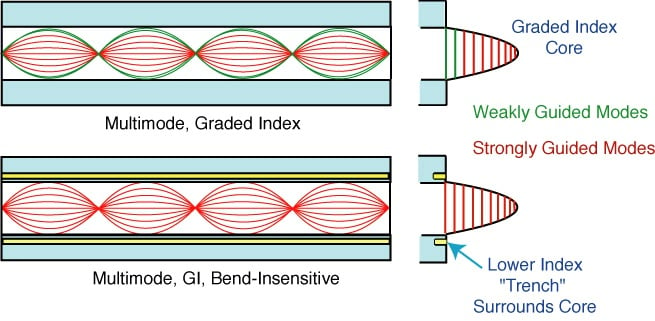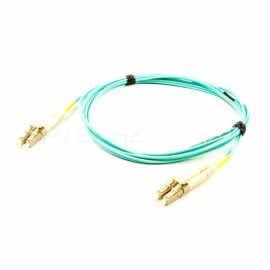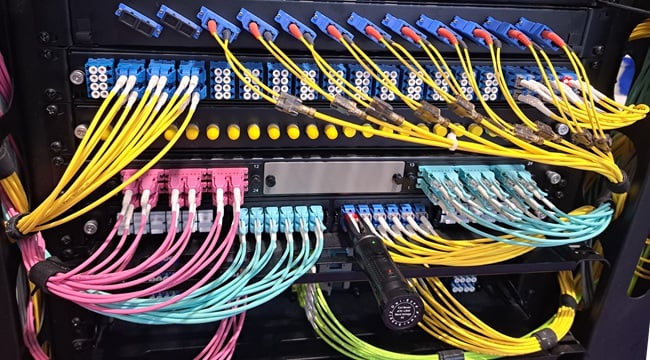Blog, Optical Networking
What is Bend-Insensitive Fiber: A Beginner’s Guide
Traditional fiber optic cables are tension-sensitive, especially sharp bends beyond the minimum bend radius. The stress affects light transmission through the fiber core, leading to significant power loss. In 2007, bend-insensitive fiber was introduced into the market to curb this problem.
Bend-insensitive fiber (BIF) is fiber optic cable that doesn’t lose transmission power even when bent beyond its average radius. The cable has an extra layer of material around its core that prevents light from escaping. But how do these cables work?
How Does Bend-Insensitive Fiber Work?
Manufacturers use refractive index trench to reduce the amount of light loss in a fiber cable bend. This entails using lower refractive index material like glass to reflect escaping light back to the core. The design reflects the “weakly guided” outer modes to the core, preventing transmission degradation. The reflective material is specially designed for maximum effect.
Traditional 62.5/125 fiber cables had better bend insensitivity than 50/125 fiber. However, the latter had outstanding bandwidth support, although more sensitive to bends. With the rising demand for fast internet speed, the solution was to reduce the 50/125 bend sensitivity, which is how BIF was invented.

Types of Bend-Insensitive Fibers
There are two types of bend-insensitive fiber:
- BI Single Mode Fiber (BISMF)
- BI Multimode Fiber (BIMMF)
Please keep reading to understand how the two types of BIF differ and their unique applications.
Bend-Insensitive Single Mode Fiber (BISMF)
As the name suggests, BISMF allows only one light mode due to its narrow core. This factor makes bend-insensitive single-mode fiber ideal for long-distance transmission with minimal signal loss, making it common in telecommunication and internet service infrastructure.
Under the International Telecommunication Union (ITU), there are two classes of BISMF, each with a varying minimum bend radius: G. 657. A and G. 657. B.
| BISMF Category | Minimum Bend Radius |
| G. 657. A1 | 10 mm |
| G. 657. A2 | 7.5 mm |
| G. 657. B1 | 7.5 mm |
| G. 657. B2 | 5 mm |
Bend-Insensitive Multimode Fiber (BIMMF)
BIMMF has a wide core, allowing multiple light modes to be transmitted. However, this leads to higher dispersion, making the cables ideal for shorter distances. Fiber optic cables’ primary applications include data centers, enterprise networks, and local area networks (LANs).
OM2, OM3, and OM4 are laser optimized and show up to 10 times resistance to signal loss. The minimum bend radius of bend-insensitive multimode fibers is 7.5mm, making the cables ideal for compact and high-density environments.
-
Product on sale
 LC-LC 9/125 OS2 Singlemode LSZH Duplex Fiber Patch CablePrice range: US$ 2.40 through US$ 27.50 (Excl. VAT)
LC-LC 9/125 OS2 Singlemode LSZH Duplex Fiber Patch CablePrice range: US$ 2.40 through US$ 27.50 (Excl. VAT) -
Product on sale
 SC-SC 9/125 OS2 Singlemode LSZH Duplex Fiber Patch CablePrice range: US$ 2.60 through US$ 27.50 (Excl. VAT)
SC-SC 9/125 OS2 Singlemode LSZH Duplex Fiber Patch CablePrice range: US$ 2.60 through US$ 27.50 (Excl. VAT) -
Product on sale
 LC-LC 10G OM3 Multimode Duplex LSZH Fiber Optic Patch CablePrice range: US$ 2.80 through US$ 40.70 (Excl. VAT)
LC-LC 10G OM3 Multimode Duplex LSZH Fiber Optic Patch CablePrice range: US$ 2.80 through US$ 40.70 (Excl. VAT)
Advantages of Bend-Insensitive Fiber
BIF offers better transmission than traditional cables. That said, let’s look at some of its merits.
- Flexibility: Bends are almost unavoidable for fiber-to-the-home (FTTH) installations. BI cables give technicians the freedom to navigate tight corners.
- Better Transmission: These cables retain the light modes even under tension, which means better performance.
- Minimal Interference: BIF can withstand stapling and clamping, common enemies of traditional fiber cables. So, technicians don’t have to worry about steep bends and exit point errors.
The flexibility of bend-insensitive fiber means minimized attenuation and bending losses, giving it an edge over conventional cables.
FAQs
Q: Does bend-insensitive fiber require particular installation or handling?
A: Yes. When installing BI fiber, adhere to the recommended bend radius. Read the manufacturer’s manual for any special measures to take during installation for optimum performance.
Q: Is bend-insensitive fiber compatible with existing optical fiber systems?
BISMF is compatible with existing cables because it only carries one mode in the core, which means minimal performance interference. However, BIMMF compatibility is not certain because of variations in core size and other factors like differential mode delay (DMD).
Q: Is BI fiber more expensive than traditional fiber optic cables?
A: Bend-insensitive fiber is more expensive than traditional cables. The additional refractive material accounts for the difference in cost. However, the benefits of bend-insensitive fiber, like functionality in tight spaces and corners, make it a better option.
Q: What are the different types of bending losses in optical fiber?
A: The primary types of bending losses in optical fiber are macro and micro. Micro-bending loss occurs when the cable is bent more than its minimum bend radius. On the other hand, macro-bending is a small, microscopic bend along the length of the fiber.
Q: What are the 3 main components of fiber optic cable?
A: The components of a fiber optic cable are the core, cladding, and coating. The core is the channel through which light travels. Cladding, on the other hand, reflects light into the core, maintaining signal transmission through internal reflection. Coating refers to the outer layer that protects the other parts from physical damage.
Q: How do I calculate the bend radius of fiber optic cable?
A: The general formula to calculate the minimum bend radius is:
Minimum Bend Radius = Cable Outer Diameter X Cable Multiplier
However, most manufacturers provide this figure. So you don’t have to worry about it.
Conclusion
Bend-insensitive fiber has revolutionized the data transmission industry. While traditional fiber optics do well in relaying data from point A to B, they have limitations, especially in handling tension. Whether you want to transmit massive data in a data center or supply internet between two tows, BIF is the solution.
Bend-insensitive multimode fiber does well in shorter distances that require massive data transmission. On the other hand, BISMF is ideal for long-distance transmission without losing the signal strength.
Reference:
Read more:
- OS1 vs OS2 Fiber, What is the Difference?
- Single Mode vs Multimode Fiber, What is The Difference?
- Fiber Color Code: A Simple Guide for Beginners
- How to calculate fiber link budget: a simple guide for beginner







